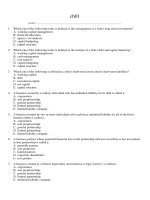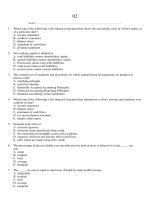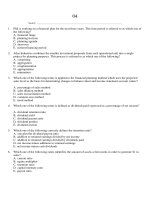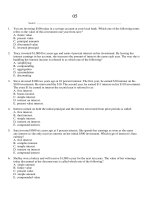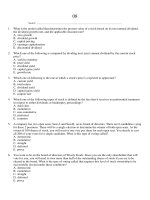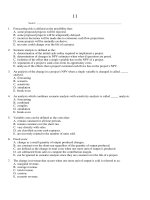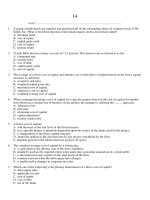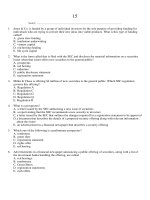Test bank fundamentals of corporate finance 9th edition chap016
Bạn đang xem bản rút gọn của tài liệu. Xem và tải ngay bản đầy đủ của tài liệu tại đây (208.54 KB, 80 trang )
Chapter 16 - Financial Leverage and Capital Structure Policy
Chapter 16
Financial Leverage and Capital Structure Policy
Multiple Choice Questions
1. Homemade leverage is:
A. the incurrence of debt by a corporation in order to pay dividends to shareholders.
B. the exclusive use of debt to fund a corporate expansion project.
C. the borrowing or lending of money by individual shareholders as a means of adjusting their
level of financial leverage.
D. best defined as an increase in a firm's debt-equity ratio.
E. the term used to describe the capital structure of a levered firm.
2. Which one of the following states that the value of a firm is unrelated to the firm's capital
structure?
A. Capital Asset Pricing Model
B. M&M Proposition I
C. M&M Proposition II
D. Law of One Price
E. Efficient Markets Hypothesis
3. Which one of the following states that a firm's cost of equity capital is directly and
proportionally related to the firm's capital structure?
A. Capital Asset Pricing Model
B. M&M Proposition I
C. M&M Proposition II
D. Law of One Price
E. Efficient Markets Hypothesis
4. Which one of the following is the equity risk that is most related to the daily operations of a
firm?
A. market risk
B. systematic risk
C. extrinsic risk
D. business risk
E. financial risk
16-1
Chapter 16 - Financial Leverage and Capital Structure Policy
5. Which one of the following is the equity risk related to a firm's capital structure policy?
A. market
B. systematic
C. extrinsic
D. business
E. financial
6. Butter & Jelly reduced its taxes last year by $350 by increasing its interest expense by
$1,000. Which of the following terms is used to describe this tax savings?
A. interest tax shield
B. interest credit
C. financing shield
D. current tax yield
E. tax-loss interest
7. The unlevered cost of capital refers to the cost of capital for a(n):
A. private entity.
B. all-equity firm.
C. governmental entity.
D. private individual.
E. corporate shareholder.
8. The explicit costs, such as legal and administrative expenses, associated with corporate
default are classified as _____ costs.
A. flotation
B. issue
C. direct bankruptcy
D. indirect bankruptcy
E. unlevered
16-2
Chapter 16 - Financial Leverage and Capital Structure Policy
9. The costs incurred by a business in an effort to avoid bankruptcy are classified as _____
costs.
A. flotation
B. direct bankruptcy
C. indirect bankruptcy
D. financial solvency
E. capital structure
10. By definition, which of the following costs are included in the term "financial distress
costs"?
I. direct bankruptcy costs
II. indirect bankruptcy costs
III. direct costs related to being financially distressed, but not bankrupt
IV. indirect costs related to being financially distressed, but not bankrupt
A. I only
B. III only
C. I and II only
D. III and IV only
E. I, II, III, and IV
11. The proposition that a firm borrows up to the point where the marginal benefit of the
interest tax shield derived from increased debt is just equal to the marginal expense of the
resulting increase in financial distress costs is called:
A. the static theory of capital structure.
B. M&M Proposition I.
C. M&M Proposition II.
D. the capital asset pricing model.
E. the open markets theorem.
12. Which one of the following is the legal proceeding under which an insolvent firm can be
reorganized?
A. restructure process
B. bankruptcy
C. forced merger
D. legal takeover
E. rights offer
16-3
Chapter 16 - Financial Leverage and Capital Structure Policy
13. A business firm ceases to exist as a going concern as a result of which one of the
following?
A. divestiture
B. share repurchase
C. liquidation
D. reorganization
E. capital restructuring
14. Edwards Farm Products was unable to meet its financial obligations and was forced into
using legal proceedings to restructure itself so that it could continue as a viable business. The
process this firm underwent is known as a:
A. merger.
B. repurchase program.
C. liquidation.
D. reorganization.
E. divestiture.
15. The absolute priority rule determines:
A. when a firm must be declared officially bankrupt.
B. how a distressed firm is reorganized.
C. which judge is assigned to a particular bankruptcy case.
D. how long a reorganized firm is allowed to remain under bankruptcy protection.
E. which parties receive payment first in a bankruptcy proceeding.
16. A firm should select the capital structure that:
A. produces the highest cost of capital.
B. maximizes the value of the firm.
C. minimizes taxes.
D. is fully unlevered.
E. equates the value of debt with the value of equity.
16-4
Chapter 16 - Financial Leverage and Capital Structure Policy
17. The value of a firm is maximized when the:
A. cost of equity is maximized.
B. tax rate is zero.
C. levered cost of capital is maximized.
D. weighted average cost of capital is minimized.
E. debt-equity ratio is minimized.
18. The optimal capital structure has been achieved when the:
A. debt-equity ratio is equal to 1.
B. weight of equity is equal to the weight of debt.
C. cost of equity is maximized given a pre-tax cost of debt.
D. debt-equity ratio is such that the cost of debt exceeds the cost of equity.
E. debt-equity ratio results in the lowest possible weighted average cost of capital.
19. AA Tours is comparing two capital structures to determine how to best finance its
operations. The first option consists of all equity financing. The second option is based on a
debt-equity ratio of 0.45. What should AA Tours do if its expected earnings before interest and
taxes (EBIT) are less than the break-even level? Assume there are no taxes.
A. select the leverage option because the debt-equity ratio is less than 0.50
B. select the leverage option since the expected EBIT is less than the break-even level
C. select the unlevered option since the debt-equity ratio is less than 0.50
D. select the unlevered option since the expected EBIT is less than the break-even level
E. cannot be determined from the information provided
20. You have computed the break-even point between a levered and an unlevered capital
structure. Assume there are no taxes. At the break-even level, the:
A. firm is just earning enough to pay for the cost of the debt.
B. firm's earnings before interest and taxes are equal to zero.
C. earnings per share for the levered option are exactly double those of the unlevered option.
D. advantages of leverage exceed the disadvantages of leverage.
E. firm has a debt-equity ratio of .50.
16-5
Chapter 16 - Financial Leverage and Capital Structure Policy
21. Which one of the following statements is correct concerning the relationship between a
levered and an unlevered capital structure? Assume there are no taxes.
A. At the break-even point, there is no advantage to debt.
B. The earnings per share will equal zero when EBIT is zero for a levered firm.
C. The advantages of leverage are inversely related to the level of EBIT.
D. The use of leverage at any level of EBIT increases the EPS.
E. EPS are more sensitive to changes in EBIT when a firm is unlevered.
22. Jessica invested in Quantro stock when the firm was unlevered. Since then, Quantro has
changed its capital structure and now has a debt-equity ratio of 0.30. To unlever her position,
Jessica needs to:
A. borrow some money and purchase additional shares of Quantro stock.
B. maintain her current equity position as the debt of the firm did not affect her personally.
C. sell some shares of Quantro stock and hold the proceeds in cash.
D. sell some shares of Quantro stock and loan out the sale proceeds.
E. create a personal debt-equity ratio of 0.30.
23. Which one of the following makes the capital structure of a firm irrelevant?
A. taxes
B. interest tax shield
C. 100 percent dividend payout ratio
D. debt-equity ratio that is greater than 0 but less than 1
E. homemade leverage
24. M&M Proposition I with no tax supports the argument that:
A. business risk determines the return on assets.
B. the cost of equity rises as leverage rises.
C. the debt-equity ratio of a firm is completely irrelevant.
D. a firm should borrow money to the point where the tax benefit from debt is equal to the
cost of the increased probability of financial distress.
E. homemade leverage is irrelevant.
16-6
Chapter 16 - Financial Leverage and Capital Structure Policy
25. The concept of homemade leverage is most associated with:
A. M&M Proposition I with no tax.
B. M&M Proposition II with no tax.
C. M&M Proposition I with tax.
D. M&M Proposition II with tax.
E. static theory proposition.
26. Which of the following statements are correct in relation to M&M Proposition II with no
taxes?
I. The required return on assets is equal to the weighted average cost of capital.
II. Financial risk is determined by the debt-equity ratio.
III. Financial risk determines the return on assets.
IV. The cost of equity declines when the amount of leverage used by a firm rises.
A. I and III only
B. II and IV only
C. I and II only
D. III and IV only
E. I and IV only
27. M&M Proposition II is the proposition that:
A. the capital structure of a firm has no effect on the firm's value.
B. the cost of equity depends on the return on debt, the debt-equity ratio, and the tax rate.
C. a firm's cost of equity is a linear function with a slope equal to (RA - RD).
D. the cost of equity is equivalent to the required rate of return on a firm's assets.
E. the size of the pie does not depend on how the pie is sliced.
28. The business risk of a firm:
A. depends on the firm's level of unsystematic risk.
B. is inversely related to the required return on the firm's assets.
C. is dependent upon the relative weights of the debt and equity used to finance the firm.
D. has a positive relationship with the firm's cost of equity.
E. has no relationship with the required return on a firm's assets according to M&M
Proposition II.
16-7
Chapter 16 - Financial Leverage and Capital Structure Policy
29. Which of the following statements related to financial risk are correct?
I. Financial risk is the risk associated with the use of debt financing.
II. As financial risk increases so too does the cost of equity.
III. Financial risk is wholly dependent upon the financial policy of a firm.
IV. Financial risk is the risk that is inherent in a firm's operations.
A. I and III only
B. II and IV only
C. II and III only
D. I, II, and III only
E. I, II, III, and IV
30. M&M Proposition I with tax supports the theory that:
A. a firm's weighted average cost of capital decreases as the firm's debt-equity ratio increases.
B. the value of a firm is inversely related to the amount of leverage used by the firm.
C. the value of an unlevered firm is equal to the value of a levered firm plus the value of the
interest tax shield.
D. a firm's cost of capital is the same regardless of the mix of debt and equity used by the
firm.
E. a firm's cost of equity increases as the debt-equity ratio of the firm decreases.
31. M&M Proposition I with taxes is based on the concept that:
A. the optimal capital structure is the one that is totally financed with equity.
B. the capital structure of a firm does not matter because investors can use homemade
leverage.
C. a firm's WACC is unaffected by a change in the firm's capital structure.
D. the value of a firm increases as the firm's debt increases because of the interest tax shield.
E. the cost of equity increases as the debt-equity ratio of a firm increases.
32. M&M Proposition II with taxes:
A. has the same general implications as M&M Proposition II without taxes.
B. states that a firm's capital structure is irrelevant.
C. supports the argument that business risk is determined by the capital structure decision.
D. supports the argument that the cost of equity decreases as the debt-equity ratio increases.
E. concludes that the capital structure decision is irrelevant to the value of a firm.
16-8
Chapter 16 - Financial Leverage and Capital Structure Policy
33. The present value of the interest tax shield is expressed as:
A. (TC × D)/RA.
B. VU + (TC × D).
C. [EBIT × (TC × D)]/RU.
D. [EBIT × (TC × D)]/RA.
E. Tc × D.
34. The interest tax shield has no value when a firm has a:
I. tax rate of zero.
II. debt-equity ratio of 1.
III. zero debt.
IV. zero leverage.
A. I and III only
B. II and IV only
C. I, III, and IV only
D. II, III, and IV only
E. I, II, and IV only
35. The interest tax shield is a key reason why:
A. the required rate of return on assets rises when debt is added to the capital structure.
B. the value of an unlevered firm is equal to the value of a levered firm.
C. the net cost of debt to a firm is generally less than the cost of equity.
D. the cost of debt is equal to the cost of equity for a levered firm.
E. firms prefer equity financing over debt financing.
36. Based on M&M Proposition II with taxes, the weighted average cost of capital:
A. is equal to the aftertax cost of debt.
B. has a linear relationship with the cost of equity capital.
C. is unaffected by the tax rate.
D. decreases as the debt-equity ratio increases.
E. is equal to RU × (1 - TC).
16-9
Chapter 16 - Financial Leverage and Capital Structure Policy
37. Bankruptcy:
A. creates value for a firm.
B. transfers value from shareholders to bondholders.
C. technically occurs when total equity equals total debt.
D. costs are limited to legal and administrative fees.
E. is an inexpensive means of reorganizing a firm.
38. Which one of the following is a direct bankruptcy cost?
A. company CEO's time spent in bankruptcy court
B. maintaining cash reserves
C. maintaining a debt-equity ratio that is lower than the optimal ratio
D. losing a key company employee
E. paying an outside accountant fees to prepare bankruptcy reports
39. If a firm has the optimal amount of debt, then the:
A. direct financial distress costs must equal the present value of the interest tax shield.
B. value of the levered firm will exceed the value of the firm if it were unlevered.
C. value of the firm is minimized.
D. value of the firm is equal to VL + TC × D.
E. debt-equity ratio is equal to 1.0.
40. Which one of the following has the greatest tendency to increase the percentage of debt
included in the optimal capital structure of a firm?
A. exceptionally high depreciation expenses
B. very low marginal tax rate
C. substantial tax shields from other sources
D. low probabilities of financial distress
E. minimal taxable income
41. The capital structure that maximizes the value of a firm also:
A. minimizes financial distress costs.
B. minimizes the cost of capital.
C. maximizes the present value of the tax shield on debt.
D. maximizes the value of the debt.
E. maximizes the value of the unlevered firm.
16-10
Chapter 16 - Financial Leverage and Capital Structure Policy
42. The optimal capital structure:
A. will be the same for all firms in the same industry.
B. will remain constant over time unless the firm changes its primary operations.
C. will vary over time as taxes and market conditions change.
D. places more emphasis on operations than on financing.
E. is unaffected by changes in the financial markets.
43. The static theory of capital structure advocates that the optimal capital structure for a
firm:
A. is dependent on a constant debt-equity ratio over time.
B. remains fixed over time.
C. is independent of the firm's tax rate.
D. is independent of the firm's weighted average cost of capital.
E. equates the tax savings from an additional dollar of debt to the increased bankruptcy costs
related to that additional dollar of debt.
44. The basic lesson of M&M Theory is that the value of a firm is dependent upon:
A. the firm's capital structure.
B. the total cash flow of the firm.
C. minimizing the marketed claims.
D. the amount of marketed claims to that firm.
E. size of the stockholders' claims.
45. Which form of financing do firms prefer to use first according to the pecking-order
theory?
A. regular debt
B. convertible debt
C. common stock
D. preferred stock
E. internal funds
16-11
Chapter 16 - Financial Leverage and Capital Structure Policy
46. Which of the following are correct according to pecking-order theory?
I. Firms stockpile internally-generated cash.
II. There is an inverse relationship between a firm's profit level and its debt level.
III. Firms avoid external debt at all costs.
IV. A firm's capital structure is dictated by its need for external financing.
A. I and III only
B. II and IV only
C. I, III, and IV only
D. I, II, and IV only
E. I, II, III, and IV
47. Corporations in the U.S. tend to:
A. minimize taxes.
B. underutilize debt.
C. rely less on equity financing than they should.
D. have relatively similar debt-equity ratios across industry lines.
E. rely more heavily on debt than on equity as the major source of financing.
48. In general, the capital structures used by U.S. firms:
A. tend to overweigh debt in relation to equity.
B. generally result in debt-equity ratios between 0.45 and 0.60.
C. are fairly standard for all SIC codes.
D. tend to be those which maximize the use of the firm's available tax shelters.
E. vary significantly across industries.
49. A firm is technically insolvent when:
A. it has a negative book value.
B. total debt exceeds total equity.
C. it is unable to meet its financial obligations.
D. it files for bankruptcy protection.
E. the market value of its stock is less than its book value.
16-12
Chapter 16 - Financial Leverage and Capital Structure Policy
50. Which one of the following statements related to Chapter 7 bankruptcy is correct?
A. A firm in Chapter 7 bankruptcy is reorganizing its operations such that it can return to
being a viable concern.
B. Under a Chapter 7 bankruptcy, a trustee will assume control of the firm's assets until those
assets can be liquidated.
C. Chapter 7 bankruptcies are always involuntary on the part of the firm.
D. Under a Chapter 7 bankruptcy, the claims of creditors are paid prior to the administrative
costs of the bankruptcy.
E. Chapter 7 bankruptcy allows a firm to restructure its equity such that new shares of stock
are generally issued prior to the firm coming out of bankruptcy.
51. Which one of the following will generally have the highest priority when assets are
distributed in a bankruptcy proceeding?
A. consumer claim
B. dividend payment to preferred shareholder
C. company contribution to the employees' retirement account
D. payment to an unsecured creditor
E. payment of employee wages
52. A firm may file for Chapter 11 bankruptcy:
I. in an attempt to gain a competitive advantage.
II. using a prepack.
III. while allowing the current management to continue running the firm.
IV. only after the firm becomes insolvent.
A. I and III only
B. I and II only
C. I, II, and IV only
D. I, II, and III only
E. I, II, III, and IV
53. The Bankruptcy Abuse Prevention and Consumer Protection Act of 2005:
A. permits creditors to file a prepack immediately after a firm files for bankruptcy protection.
B. prevents creditors from submitting any reorganization plans.
C. prevents firms from filing for bankruptcy protection more than once.
D. permits key employee retention plans only if an employee has another job offer.
E. allows firms to pay bonuses to all key employees to entice those employees to remain in
the firm's employ.
16-13
Chapter 16 - Financial Leverage and Capital Structure Policy
54. Kelso Electric is debating between a leveraged and an unleveraged capital structure. The
all equity capital structure would consist of 40,000 shares of stock. The debt and equity option
would consist of 25,000 shares of stock plus $280,000 of debt with an interest rate of 7
percent. What is the break-even level of earnings before interest and taxes between these two
options? Ignore taxes.
A. $42,208
B. $44,141
C. $46,333
D. $49,667
E. $52,267
55. Holly's is currently an all equity firm that has 9,000 shares of stock outstanding at a
market price of $42 a share. The firm has decided to leverage its operations by issuing
$120,000 of debt at an interest rate of 9.5 percent. This new debt will be used to repurchase
shares of the outstanding stock. The restructuring is expected to increase the earnings per
share. What is the minimum level of earnings before interest and taxes that the firm is
expecting? Ignore taxes.
A. $35,910
B. $38,516
C. $42,000
D. $44,141
E. $45,020
56. Sewer's Paradise is an all equity firm that has 5,000 shares of stock outstanding at a
market price of $15 a share. The firm's management has decided to issue $30,000 worth of
debt and use the funds to repurchase shares of the outstanding stock. The interest rate on the
debt will be 10 percent. What are the earnings per share at the break-even level of earnings
before interest and taxes? Ignore taxes.
A. $1.46
B. $1.50
C. $1.67
D. $1.88
E. $1.94
16-14
Chapter 16 - Financial Leverage and Capital Structure Policy
57. Miller's Dry Goods is an all equity firm with 45,000 shares of stock outstanding at a
market price of $50 a share. The company's earnings before interest and taxes are $128,000.
Miller's has decided to add leverage to its financial operations by issuing $250,000 of debt at
8 percent interest. The debt will be used to repurchase shares of stock. You own 400 shares of
Miller's stock. You also loan out funds at 8 percent interest. How many shares of Miller's
stock must you sell to offset the leverage that Miller's is assuming? Assume you loan out all of
the funds you receive from the sale of stock. Ignore taxes.
A. 35.6 shares
B. 40.0 shares
C. 44.4 shares
D. 47.5 shares
E. 50.1 shares
58. You currently own 600 shares of JKL, Inc. JKL is an all equity firm that has 75,000 shares
of stock outstanding at a market price of $40 a share. The company's earnings before interest
and taxes are $140,000. JKL has decided to issue $1 million of debt at 8 percent interest. This
debt will be used to repurchase shares of stock. How many shares of JKL stock must you sell
to unlever your position if you can loan out funds at 8 percent interest?
A. 120 shares
B. 150 shares
C. 180 shares
D. 200 shares
E. 250 shares
59. Naylor's is an all equity firm with 60,000 shares of stock outstanding at a market price of
$50 a share. The company has earnings before interest and taxes of $87,000. Naylor's has
decided to issue $750,000 of debt at 7.5 percent. The debt will be used to repurchase shares of
the outstanding stock. Currently, you own 500 shares of Naylor's stock. How many shares of
Naylor's stock will you continue to own if you unlever this position? Assume you can loan out
funds at 7.5 percent interest. Ignore taxes.
A. 300 shares
B. 350 shares
C. 375 shares
D. 425 shares
E. 500 shares
16-15
Chapter 16 - Financial Leverage and Capital Structure Policy
60. Pewter & Glass is an all equity firm that has 80,000 shares of stock outstanding. The
company is in the process of borrowing $600,000 at 9 percent interest to repurchase 12,000
shares of the outstanding stock. What is the value of this firm if you ignore taxes?
A. $2.5 million
B. $4.0 million
C. $5.0 million
D. $5.5 million
E. $6.0 million
61. The Jean Outlet is an all equity firm that has 146,000 shares of stock outstanding. The
company has decided to borrow the $1.1 million to repurchase 7,500 shares of its stock from
the estate of a deceased shareholder. What is the total value of the firm if you ignore taxes?
A. $18,387,702
B. $18,500,000
C. $19,666,667
D. $21,000,000
E. $21,413,333
62. Stacy owns 38 percent of The Town Centre. She has decided to retire and wants to sell all
of her shares in this closely held, all equity firm. The other shareholders have agreed to have
the firm borrow $650,000 to purchase her shares of stock. What is the total market value of
The Town Centre? Ignore taxes.
A. $1,710,526
B. $1,748,219
C. $1,771,089
D. $1,801,406
E. $1,808,649
63. Winter's Toyland has a debt-equity ratio of 0.72. The pre-tax cost of debt is 8.7 percent
and the required return on assets is 16.1 percent. What is the cost of equity if you ignore
taxes?
A. 19.31 percent
B. 19.74 percent
C. 20.29 percent
D. 20.46 percent
E. 21.43 percent
16-16
Chapter 16 - Financial Leverage and Capital Structure Policy
64. Jefferson & Daughter has a cost of equity of 14.6 percent and a pre-tax cost of debt of 7.8
percent. The required return on the assets is 13.2 percent. What is the firm's debt-equity ratio
based on M&M II with no taxes?
A. 0.26
B. 0.33
C. 0.37
D. 0.43
E. 0.45
65. The Corner Bakery has a debt-equity ratio of 0.54. The firm's required return on assets is
14.2 percent and its cost of equity is 16.1 percent. What is the pre-tax cost of debt based on
M&M Proposition II with no taxes?
A. 7.10 percent
B. 8.79 percent
C. 10.68 percent
D. 17.56 percent
E. 18.40 percent
66. L.A. Clothing has expected earnings before interest and taxes of $48,900, an unlevered
cost of capital of 14.5 percent, and a tax rate of 34 percent. The company also has $8,000 of
debt that carries a 7 percent coupon. The debt is selling at par value. What is the value of this
firm?
A. $222,579.31
B. $223,333.33
C. $224,108.16
D. $225,299.31
E. $225,476.91
16-17
Chapter 16 - Financial Leverage and Capital Structure Policy
67. Hanover Tech is currently an all equity firm that has 320,000 shares of stock outstanding
with a market price of $19 a share. The current cost of equity is 15.4 percent and the tax rate
is 36 percent. The firm is considering adding $1.2 million of debt with a coupon rate of 8
percent to its capital structure. The debt will be sold at par value. What is the levered value of
the equity?
A. $5.209 million
B. $5.312 million
C. $5.436 million
D. $6.512 million
E. $6.708 million
68. Bright Morning Foods has expected earnings before interest and taxes of $48,600, an
unlevered cost of capital of 13.2 percent, and debt with both a book and face value of
$25,000. The debt has an 8.5 percent coupon. The tax rate is 34 percent. What is the value of
the firm?
A. $245,500
B. $247,600
C. $251,500
D. $264,800
E. $271,300
69. Exports Unlimited is an unlevered firm with an aftertax net income of $47,800. The
unlevered cost of capital is 14.1 percent and the tax rate is 32 percent. What is the value of
this firm?
A. $270,867
B. $294,380
C. $339,007
D. $378,444
E. $447,489
16-18
Chapter 16 - Financial Leverage and Capital Structure Policy
70. An unlevered firm has a cost of capital of 17.5 percent and earnings before interest and
taxes of $327,500. A levered firm with the same operations and assets has both a book value
and a face value of debt of $650,000 with a 7.5 percent annual coupon. The applicable tax rate
is 38 percent. What is the value of the levered firm?
A. $1,397,212
B. $1,398,256
C. $1,402,509
D. $1,407,286
E. $1,414,414
71. Down Bedding has an unlevered cost of capital of 13 percent, a cost of debt of 7.8
percent, and a tax rate of 32 percent. What is the target debt-equity ratio if the targeted cost of
equity is 15.51 percent?
A. .63
B. .68
C. .71
D. .76
E. .84
72. Johnson Tire Distributors has debt with both a face and a market value of $12,000. This
debt has a coupon rate of 6 percent and pays interest annually. The expected earnings before
interest and taxes are $2,100, the tax rate is 30 percent, and the unlevered cost of capital is
11.7 percent. What is the firm's cost of equity?
A. 22.46 percent
B. 22.87 percent
C. 23.20 percent
D. 23.59 percent
E. 25.14 percent
16-19
Chapter 16 - Financial Leverage and Capital Structure Policy
73. Country Markets has an unlevered cost of capital of 12 percent, a tax rate of 38 percent,
and expected earnings before interest and taxes of $15,700. The company has $11,000 in
bonds outstanding that have a 6 percent coupon and pay interest annually. The bonds are
selling at par value. What is the cost of equity?
A. 12.55 percent
B. 13.36 percent
C. 13.64 percent
D. 14.07 percent
E. 14.29 percent
74. The Pizza Palace has a cost of equity of 15.3 percent and an unlevered cost of capital of
11.8 percent. The company has $22,000 in debt that is selling at par value. The levered value
of the firm is $41,000 and the tax rate is 34 percent. What is the pre-tax cost of debt?
A. 4.73 percent
B. 6.18 percent
C. 6.59 percent
D. 7.22 percent
E. 9.92 percent
75. The Green Paddle has a cost of equity of 13.73 percent and a pre-tax cost of debt of 7.6
percent. The debt-equity ratio is 0.65 and the tax rate is 32 percent. What is Green Paddle's
unlevered cost of capital?
A. 11.85 percent
B. 12.78 percent
C. 14.29 percent
D. 14.46 percent
E. 15.08 percent
76. Bob's Warehouse has a pre-tax cost of debt of 8.4 percent and an unlevered cost of capital
of 14.6 percent. The firm's tax rate is 37 percent and the cost of equity is 18 percent. What is
the firm's debt-equity ratio?
A. 0.72
B. 0.76
C. 0.79
D. 0.82
E. 0.87
16-20
Chapter 16 - Financial Leverage and Capital Structure Policy
77. Douglass & Frank has a debt-equity ratio of 0.45. The pre-tax cost of debt is 7.6 percent
while the unlevered cost of capital is 13.3 percent. What is the cost of equity if the tax rate is
39 percent?
A. 13.79 percent
B. 14.86 percent
C. 15.92 percent
D. 18.40 percent
E. 18.87 percent
78. The June Bug has a $270,000 bond issue outstanding. These bonds have a 7.5 percent
coupon, pay interest semiannually, and have a current market price equal to 98.6 percent of
face value. The tax rate is 39 percent. What is the amount of the annual interest tax shield?
A. $3,948.75
B. $4,112.60
C. $5,311.22
D. $7,897.50
E. $8,225.20
79. Georga's Restaurants has 4,500 bonds outstanding with a face value of $1,000 each and a
coupon rate of 8.25 percent. The interest is paid semi-annually. What is the amount of the
annual interest tax shield if the tax rate is 37 percent?
A. $137,362.50
B. $162,411.90
C. $187,750.00
D. $210,420.00
E. $233,887.50
80. D. L. Tuckers has $21,000 of debt outstanding that is selling at par and has a coupon rate
of 7.5 percent. The tax rate is 32 percent. What is the present value of the tax shield?
A. $504
B. $615
C. $644
D. $6,200
E. $6,720
16-21
Chapter 16 - Financial Leverage and Capital Structure Policy
81. Jemisen's has expected earnings before interest and taxes of $6,200. Its unlevered cost of
capital is 13 percent and its tax rate is 34 percent. The firm has debt with both a book and a
face value of $2,500. This debt has a 9 percent coupon and pays interest annually. What is the
firm's weighted average cost of capital?
A. 12.48 percent
B. 12.66 percent
C. 13.87 percent
D. 14.14 percent
E. 14.37 percent
82. A firm has debt of $12,000, a leveraged value of $26,400, a pre-tax cost of debt of 9.20
percent, a cost of equity of 17.6 percent, and a tax rate of 37 percent. What is the firm's
weighted average cost of capital?
A. 11.47 percent
B. 11.52 percent
C. 11.69 percent
D. 12.23 percent
E. 12.48 percent
83. Young's Home Supply has a debt-equity ratio of 0.80. The cost of equity is 14.5 percent
and the aftertax cost of debt is 4.9 percent. What will the firm's cost of equity be if the debtequity ratio is revised to 0.75?
A. 10.89 percent
B. 11.47 percent
C. 11.70 percent
D. 13.89 percent
E. 14.23 percent
84. Percy's Wholesale Supply has earnings before interest and taxes of $106,000. Both the
book and the market value of debt is $170,000. The unlevered cost of equity is 15.5 percent
while the pre-tax cost of debt is 8.6 percent. The tax rate is 38 percent. What is the firm's
weighted average cost of capital?
A. 11.94 percent
B. 12.65 percent
C. 13.45 percent
D. 14.01 percent
E. 14.37 percent
16-22
Chapter 16 - Financial Leverage and Capital Structure Policy
Essay Questions
85. Draw the following two graphs, one above the other: In the top graph, plot firm value on
the vertical axis and total debt on the horizontal axis. Use this graph to illustrate the value of a
firm under M&M without taxes, M&M with taxes, and the static theory of capital structure.
On the lower graph, plot the WACC on the vertical axis and the debt-equity ratio on the
horizontal axis. Use this second graph to illustrate the value of the firm's WACC under M&M
without taxes, M&M with taxes, and the static theory. Briefly explain what the two graphs
reveal about firm value and its cost of capital under the three different theories.
86. Based on the M&M propositions with and without taxes, how much time should a
financial manager spend analyzing the capital structure of a firm? What if the analysis is
based on the static theory?
87. Pete is the CFO of Dexter International. He would like to increase the debt-equity ratio of
the firm but is concerned that the firm's shareholders may not be willing to accept additional
financial leverage. Pete has come to you for advice. What is your recommendation?
16-23
Chapter 16 - Financial Leverage and Capital Structure Policy
88. In each of the theories of capital structure, the cost of equity increases as the amount of
debt increases. So why don't financial managers use as little debt as possible to keep the cost
of equity down? After all, aren't financial managers supposed to maximize the value of a
firm?
89. Explain how a firm loses value during the bankruptcy process from both a creditors and a
shareholders perspective.
Multiple Choice Questions
90. East Side, Inc. has no debt outstanding and a total market value of $136,000. Earnings
before interest and taxes, EBIT, are projected to be $12,000 if economic conditions are
normal. If there is strong expansion in the economy, then EBIT will be 27 percent higher. If
there is a recession, then EBIT will be 55 percent lower. East Side is considering a $54,000
debt issue with a 5 percent interest rate. The proceeds will be used to repurchase shares of
stock. There are currently 2,000 shares outstanding. Ignore taxes. If the economy enters a
recession, EPS will change by ____ percent as compared to a normal economy, assuming that
the firm recapitalizes.
A. -70.97 percent
B. -63.15 percent
C. -58.08 percent
D. -42.29 percent
E. -38.87 percent
16-24
Chapter 16 - Financial Leverage and Capital Structure Policy
91. North Side, Inc. has no debt outstanding and a total market value of $175,000. Earnings
before interest and taxes, EBIT, are projected to be $16,000 if economic conditions are
normal. If there is strong expansion in the economy, then EBIT will be 35 percent higher. If
there is a recession, then EBIT will be 70 percent lower. North Side is considering a $70,000
debt issue with a 7 percent interest rate. The proceeds will be used to repurchase shares of
stock. There are currently 2,500 shares outstanding. North Side has a tax rate of 34 percent. If
the economy expands strongly, EPS will change by ____ percent as compared to a normal
economy, assuming that the firm recapitalizes.
A. 38.80 percent
B. 45.26 percent
C. 50.45 percent
D. 53.92 percent
E. 61.07 percent
92. Galaxy Products is comparing two different capital structures, an all-equity plan (Plan I)
and a levered plan (Plan II). Under Plan I, Galaxy would have 178,500 shares of stock
outstanding. Under Plan II, there would be 71,400 shares of stock outstanding and $1.79
million in debt outstanding. The interest rate on the debt is 10 percent and there are no taxes.
What is the breakeven EBIT?
A. $287,878.78
B. $298,333.33
C. $351,111.11
D. $333,333.33
E. $341,414.14
93. ABC Co. and XYZ Co. are identical firms in all respects except for their capital structure.
ABC is all equity financed with $480,000 in stock. XYZ uses both stock and perpetual debt;
its stock is worth $240,000 and the interest rate on its debt is 11 percent. Both firms expect
EBIT to be $58,400. Ignore taxes. The cost of equity for ABC is _____ percent, and for XYZ
it is ______ percent.
A. 12.17; 12.68
B. 12.17; 12.94
C. 12.17; 13.33
D. 12.29; 12.68
E. 12.29; 13.33
16-25
